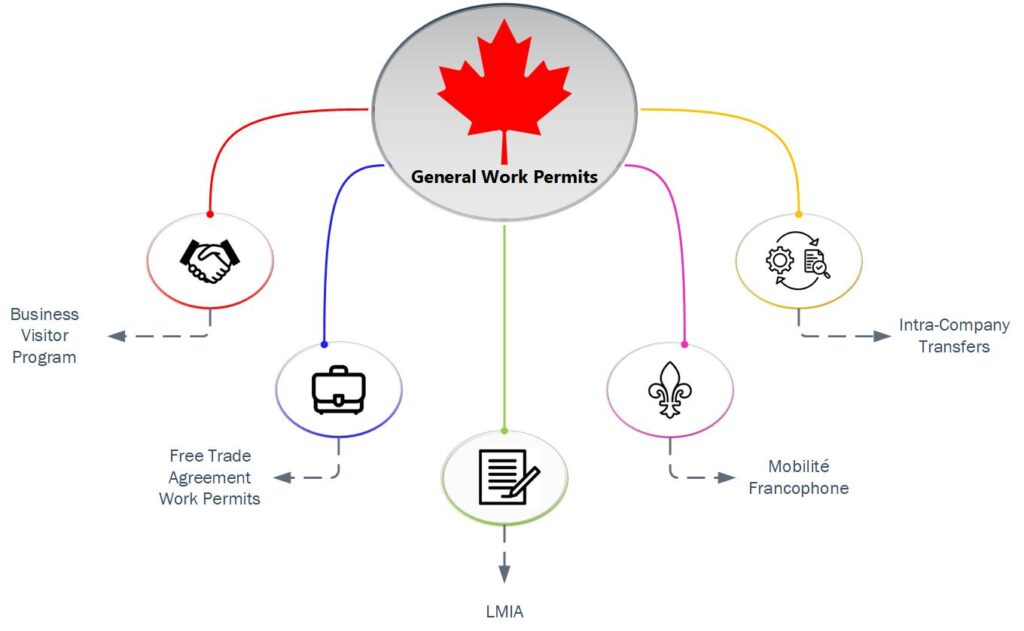Explore the world of General Work Permits: Eligibility, Application Process and Benefits for international job seekers in Canada
Canada is known for its diverse and thriving economy, attracting professionals, entrepreneurs, and workers from around the world. To facilitate this global talent influx, Canada has established various immigration pathways and work permit programs to suit different needs and situations. In this article, we will provide a summary of several prominent Canadian General Work Permits: Business Visitor, Labour Market Impact Assessment (LMIA), Free Trade Agreement Work Permits, Mobilité Francophone, and Intra-Company Transfers.

1. Business Visitor Program
The Business Visitor Program is designed for foreign nationals seeking to engage in temporary international business activities in Canada without directly entering the Canadian labour market and the need for a work permit. Business visitors can participate in activities such as attending meetings with people from companies who they are conducting business with, conferences, trade shows, negotiating contracts, conducting market research, or to observe site visits. It is crucial to note that business visitors cannot engage in hands-on employment in Canada.
2. Labour Market Impact Assessment (LMIA)
The LMIA process is essential for employers in Canada who wish to hire foreign workers. It assesses the impact of hiring a foreign worker on the Canadian labor market. Employers must demonstrate that no Canadian citizen or permanent resident is available for the position. If approved, the foreign worker can then apply for a work permit to fill the job vacancy. The LMIA process is complex and involves various factors, such as advertising and recruitment efforts. The LMIA application usually consists of a lengthy process preparing, submitting and processing. However, there are programs where a foreign talent and the company hiring them, eliminates certain lengthy aspect of the steps taken for an LMIA application making the LMIA processing time much faster. One of the major steps that this other program, within the LMIA, eliminates is the requirement for a business to attempt to recruit a Canadian talent for the position first.
3. Free Trade Agreement Work Permits
Canada has several bilateral and multilateral Free Trade Agreements (FTAs) that permit foreign workers from a number of countries to work in Canada. These agreements do not create an open market for foreign nationals from these countries to work, but stipulate which occupations qualify for LMIA-exempt work. Under these agreements, professionals, investors, and other eligible individuals can obtain work permits more easily. Common FTAs include the North American Free Trade Agreement (NAFTA), now known as the Canada-United States-Mexico Agreement (CUSMA), which allows for streamlined work permits for citizens of these countries. To qualify for a work permit under a FTA, a foreign national must be working in an occupation permitted under that agreement and must meet the job qualifications set out for that particular occupation. To learn more, see here.
4. Mobilité Francophone
Mobilité Francophone is a unique immigration program that promotes the mobility of French-speaking foreign workers and their families to Canada. To be eligible, candidates do not need to work in a French speaking workplace while in Canada, but they must establish that they can speak and listen in French at an intermediate level. A foreign national must demonstrate French proficiency by providing written confirmation from a college or university in a program that was completed in French or by scoring a Canadian Language Benchmark or Niveau de compétence linguistique canadien level 5 or higher in the Test d’Evaluation de Français or Test de connaissance du français. To be eligible, candidates must have a job offer in a French-speaking province or territory outside of Quebec. This initiative aims to strengthen Canada’s French-speaking communities and promote the use of the French language.
5. Intra-Company Transfers
The Intra-Company Transfer is designed for multinational companies with offices or affiliates in Canada. This program permits for qualified specialized knowledge employees, managers, and executives to transfer to the Canadian branch of their company for a specified period. The benefit of this program is that it streamlines the process for transferring employees, eliminating the need for an LMIA in most cases.
General Work Permits Conclusion
Canada’s immigration system offers a variety of pathways for individuals seeking temporary employment or business opportunities within the country. Whether you are a business visitor, a skilled worker under an LMIA, a professional benefiting from a Free Trade Agreement, a Francophone looking for work, or part of an intra-company transfer, there are options available to suit your needs.
Navigating these programs can be complex, and requirements may change over time, so it is essential to consult official government resources or seek legal advice when considering Canadian immigration. With the right approach and understanding of the available pathways, individuals can harness the opportunities that Canada has to offer and contribute to its diverse and dynamic workforce.
